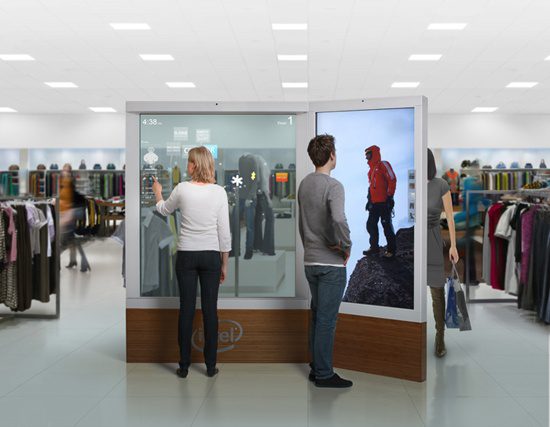Whenever we mention ‘retail stores of the future’ it may not necessarily mean customers arriving in hover cars or presence of virtual assistants inside the store. No false hopes but we are far away from such a future.
But what we do expect for sure in the very near future is a fully grown technology-driven omnichannel shopping experience for the customers. The focus shall shift from physical stores and retail strategies will become more and more customer-centric. Retailing will move further up in the chain of customer shopping process. This process involves need realization, options evaluation, purchase decision, purchase, need satisfaction and return.
In this pursuit, retail stores in the future would revolve around these ideas and technologies.
Smartphones
Smartphones are quickly becoming an immensely powerful tool for buying and selling. And this would not have been possible without internet and mobile applications. And with every upgrade, these smartphones are getting smarter every day. With a smartphone in our pocket, internet is all set to become more and more pervasive in our lives and lifestyles.
The smartphone will become the new shopping destination. More and more retailer enterprises will rely on internet, will be app based and will try to push their services through mobile apps.
Digital payment in retail stores
Although, digital payment is widely used in many parts of the world for making shopping payments but with changing government regulations and convenience on the part of customers and retailers, it might soon replace cash as the standard mode of payment for buying and selling especially in urban and semi-urban areas.
Digital payment solutions like internet banking apps, mobile wallets, unified payment apps, debit cards, NFC or beacon technology are set to become the standard for payment in the retail stores. For both the customers and the retailers, digital payment is convenient, hassle free and less prone to human errors and frauds. With financial inclusion, more and more customers will come under the umbrella of banking and it is expected that there will be a widespread use of available digital payment solutions.
Automated sale
We already have services which remind us to make necessary payments and renewals before due date. In the future not very far away from here, technology will take a big leap and would become capable of doing some of the purchases and shopping for us.
Payment for goods and services like online movie streaming, mobile phone prepaid and postpaid usage, monthly grocery items etc. are all going to get streamlined and brought under one roof. This, of course, with the prior approval and confirmation from the customer. One could fancy thinking if it would be like uttering ‘repeat’ and the waiter shall understand what to serve next.
AV Support
Customer support is one of the key parameters of customer satisfaction. In the future, customer support will be more easily accessible. Rather than customer reaching out for product support, it is retail stores which will try to remain close to their customers.
With internet connectivity and smartphones, retail stores will aim to align their customer support systems parallel to the various stages of customers’ experience with the products and services. AV based customer care will replace telecalling support wherein product queries, installation and usage procedures or complaint resolution will be addressed to the buyers in AV format or demonstrated over video calling.
Millennials and Gen-Z
Compared to the last decade, there has been a sea change in customer demographics. The market segment comprising of the Millennials and Generation Z customers shall continue to expand and validate itself as the largest and most potential customer base.
Products and services will be more frequently redesigned keeping in mind the changing needs and aspirations of the younger generations. While competitive pricing will prevail, more and more retail enterprises will adopt flexible payment options like EMI or easy credit. It is very likely that retail stores will be equipped with necessary technology in the store to help customers choose their products and services. For example, more and more hair salons and studios will have a screen monitor wherein customers can try virtual hairstyles and virtual makeovers before finalizing on one.
Online-offline war
It can be expected that the tug of war between online and offline retail channels will go dimmer as we head towards the end of this decade. This is mainly because more and more retail stores will switch over to being omnichannel. It may appear like a truce but it actually is acceptance and adoption of digital prowess. It will be significantly advantageous for retailers and retail stores to integrate digital technology into their marketing and retail activities. But it isn’t too far from here that this position of advantage will quickly turn to become a survival necessity. In product promotion, receiving orders, accepting payments or registering and resolving customers complaints, the use of digital technology will help retail stores improve their customers’ overall experience with the product.
In isolation, these factors may look controllable. But the cumulative and overlapping effect of these factors cannot be undermined. Retail stores of the future will try to integrate these elements and create a seamless weave of retail activities to enhance customers’ shopping experience.
To know more about “How you can enhance your customer experience?” get in touch with YRC Business Experts on [email protected]
YRC Related Articles: How to Write SOPs for Marketing?, 6 Ways To Grow Your Business, How to Start a Retail Business in India, Business Expansion Plan for Small Entrepreneurs, Six Steps to Writing a Great SOP for Retail, How to write SOPs for an Apparel Brand?, How to Develop SOPs for Quick Service Restaurant?, How to write SOPs for Furniture Showroom
Author Bio

Rupal Agarwal
Chief Strategy Officer










